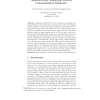Free Online Productivity Tools
i2Speak
i2Symbol
i2OCR
iTex2Img
iWeb2Print
iWeb2Shot
i2Type
iPdf2Split
iPdf2Merge
i2Bopomofo
i2Arabic
i2Style
i2Image
i2PDF
iLatex2Rtf
Sci2ools
ACNS
2011
Springer
2011
Springer
Quantitatively Analyzing Stealthy Communication Channels
Abstract. Attackers in particular botnet controllers use stealthy messaging systems to set up large-scale command and control. Understanding the capacity of such communication channels is important in detecting organized cyber crimes. We analyze the use of domain name service (DNS) as a stealthy botnet command-and-control channel, which allows multiple entities to pass messages stored in DNS records to each other. We describe and quantitatively analyze new techniques that can be used to hide malicious DNS activities both at the host and network levels. We also present and experimentally evaluate statistical content-analysis techniques as a countermeasure, which require deep packet inspection. Our techniques are beyond the specific DNS security problem studied. We give a formal definition for the perfect stealth of a communication channel; point out the fundamental limits in achieving it, as well as the practical issues in the detection. We perform comprehensive statistical analysis t...
| Added | 24 Aug 2011 |
| Updated | 24 Aug 2011 |
| Type | Journal |
| Year | 2011 |
| Where | ACNS |
| Authors | Patrick Butler, Kui Xu, Danfeng (Daphne) Yao |
Comments (0)

